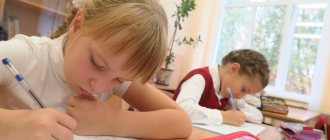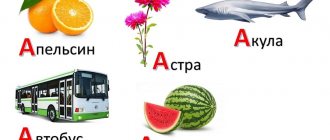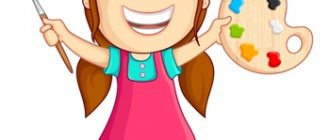Dyslexia begins to manifest itself most clearly in primary school.
At the age of 7-8 years, a child cannot cope with mastering reading skills. He confuses syllables, composes words slowly, and even if he can read a sentence, he cannot understand the meaning of what is being said. At the same time, the student is distinguished by a normal level of mental development and a rich imagination. Experts say that early treatment of dyslexia can eliminate the pathology or, at a minimum, help the child successfully cope with its manifestations. The disease is treated by a speech therapist or defectologist with a narrow specialization, but the therapeutic process must take place in close cooperation with the baby’s parents.
If your younger student has obvious difficulties in mastering reading skills or is at increased risk of developing this deviation, then the tasks and exercises presented below will suit you perfectly. They will help the student develop logical thinking and abstract concepts, develop reading and perception skills, and also increase concentration.
Articulation gymnastics
You should start your classes with warm-up exercises:
- inhale through the nose and exhale through the mouth;
- inhale - hold your breath for a few seconds - exhale;
- We take an incomplete breath and do not exhale the air completely.
This is followed by exercises that develop clarity and intelligibility of pronunciation. The child is asked to complete phrases with associative sounds:
- a fly flies around the room “z-z-z”;
- the dog growls at the cat “rrrr”;
- a snake crawls in the grass “sh-sh-sh”;
- a bumblebee lands on a flower “w-w-w”;
- a horse runs across the field “clack-clack-clack”, etc.
Take a deep breath and, on one exhale, read all the consonants in the line:
- KNSHLZZTSSBTMPVCHF;
- VMRGKTBDZSHCHZBCHVN;
- VDGBFKZRChPTKZRM;
- ChMKPBRVSFSHMZHDSHH.
Read the phrases slowly and clearly:
- ru-ru-ru - the keguru ran away;
- you-you-you - the cats meowed;
- chi-chi-chi - all the balls rolled.
Read in a whisper at a moderate pace:
- arna – arla;
- arzha – arch;
- arla – arma;
- arba - harp.
Read out loud and as quickly as possible:
- burn – oven – lie down;
- door – worm – beast;
- chalk - stake - silt;
- fry - steam - burn.
Read aloud tongue twisters, sayings and proverbs:
- as is the fiber, so is the linen;
- whether they watered the lily, whether they saw Lydia;
- the ships tacked, tacked, but did not tack;
- Geese cackle on the mountain, a fire burns under the mountain;
- our duda is both here and there.
Exercises to correct dyslexia
Learning to write is the most difficult period of schooling. The number of schoolchildren making multiple specific mistakes is constantly increasing. Adults often associate these mistakes with absent-mindedness.
Special work to overcome dyslexia is based on performing special exercises aimed at developing all aspects of speech. In addition, exercises affect the development of fine motor skills, mental processes, and also normalize the emotional-volitional sphere. They form the rudiments for the correct development of written speech, increase the level of general development, enrich the vocabulary, and improve the sense of language.
Exercises to develop phonemic processes
Exercises train phonemic hearing, perception, and memory. They develop the ability to isolate a given phoneme from a word, determine their number in words, and the skill of selecting words with a given number of phonemes.
Differentiate oppositional voiced and voiceless, soft and hard consonant sounds. Discrimination is carried out according to the following algorithm: listen, pronounce, distinguish, write down. At the stage of pronouncing syllables, you need to connect a kinesthetic analyzer, for example: raise your hand for voiced phonemes, and lower your hand for voiceless phonemes.
Determine the sonority of sounds. After mastering the differences in the articulation of voiced and voiceless phonemes, tablets with their symbols are prepared. On one you need to draw a triangle, on the other you need to draw a circle. The child is asked to listen to the words, determine what sound they begin with, and pick up the appropriate card. After oral practice, words are written either in two columns, or only with voiceless consonants, or only with voiced consonants.
Name a word that is different from the others. Discrimination by ear of phonemes that are similar in acoustic parameters, exact repetition of all words with them.
Ball games. They are aimed at the formation of phonemic processes, general and fine motor skills, spatial orientation, regulation of purposeful movements, improvement of accuracy and dexterity. Thanks to them, attention is activated and the behavioral sphere is normalized:
- “I know a lot of words.” The child needs to pronounce several words on a specific topic or starting with a specific sound; when pronouncing each word, you can use a ball, knocking it on the floor when pronouncing.
- "Know-it-all." The adult asks a question, passing the ball to the child. The child catches the ball and answers the question with an extended phrase. All words in the answer begin with one specific sound.
- "Accountant". An adult says a word and throws a ball. The child needs to catch the ball, count the number of sounds in the word and say a word containing the same number of phonemes by throwing the ball back.
Exercises for the development of the speech apparatus and voice
Exercises that develop articulatory clarity, breathing, and voice affect the success of mastering school material. They are based on pronouncing tongue twisters, rhythmic texts, poems, imply the exact repetition of what was heard, and allow you to feel the speech rhythm and tempo.
Insufficient activity of the articulatory organs, accuracy in performing given patterns, and impaired breathing lead to learning difficulties. Work on the development of the speech apparatus contains articulatory and breathing exercises. Producing correct exhalation optimizes the functioning of the circulatory system and has a beneficial effect on the functioning of the entire body.
Smooth breathing allows you to relax and concentrate. The breathing rhythm is the only rhythm of the body that a person is able to consciously control and actively regulate. Breathing exercises can be performed at any stage of the lesson. These include playing wind musical instruments, blowing soap bubbles, and imitating natural processes: sucking, yawning, coughing.
A special place in the development of articulatory organs belongs to the work on tongue twisters. It solves many problems: improving phonemic processes, clarifying the articulatory structure of phonemes, practicing articulatory clarity, long, correct exhalation, memory development, eliminating the fear of pronouncing complex words, ensuring a positive psychological attitude. It allows you to catch speech rhythm, tempo, and helps increase the speed of both oral and written speech.
Exercises to develop fine motor skills
Exercises that develop hand motor skills can improve the emotional state, develop memory and speech. To develop fine motor skills, you can use massage, finger exercises, games, shading, modeling, and drawing. Origami is also suitable:
Exercises to improve visual perception
Performing proofreading tests is well suited for developing work on visual processes. They are necessary to correct visual attention, perception, and create a visual image of a letter.
- "Fly". In the center of the square, divided into cells, a fly is depicted. The adult dictates the path of its movement, for example, 2 cells to the right, 3 cells down, etc. First, the child moves his finger along the cells, then mentally imagines its movement. At the final stage, the child, with his eyes closed, must imagine the path and say in which cell he needs to stop.
- "Upside down". The sheet with printed text unfolds several degrees. The child must read the text without turning his head.
- “Find out from the half letter.” The upper or lower half of the line is covered with a white sheet of paper or part of the line is sealed, the child must read the sentence. This test forms a visual image of letters, the ability to quickly read one or several words at the same time.
- "Lame text." The child is asked to read sentences that are printed in two fonts. Explain their meaning. Note the specifics of writing. Read what is shown in printed font and what is in italics. Copy words printed in the same font. Read the resulting sentence.
Game "What's in the chest?"
For this exercise you need to make three-dimensional letters of the alphabet. They can be made from plasticine, clay, or cut out of hard cardboard. The lettering material is placed in a box or opaque bag. The child is offered several options for this game:
- It is necessary, without taking it out of the box, to identify the letter of the alphabet by touch and describe it. After this, take out the letter, make sure the answer is correct and make words with it. You can make the task more difficult by requiring that this particular letter be at the beginning, end, or middle of the word the child comes up with.
- The box contains letters that can be used to form several short words. The child takes out the letters, completes the task, and then comes up with sentences with the solved word.
Kornev's technique
Kornev’s method for eliminating dyslexia is based on early diagnosis of pathology using tests. For example, the child must name objects in order and say their purpose, repeat the movements after the teacher, repeat the rhythm, identify the left and right arm/leg. The same exercises are used in classes to correct dyslexia.
The author has developed a technique that includes selecting an individual learning pace, monitoring new skills, and using a game form of learning.
Game "ladder"
The child is asked to read words with different numbers of syllables, which are arranged in the form of a ladder: HEDGEHOG CANCER HIS LUM HORSE GIRL PRESIDENT GEAR SILKY
In this case, the student needs to complete several tasks:
- read the words located in the “ladder” from top to bottom;
- If you come across an incomprehensible word, you should find out what it means and read it several times;
- if the word is difficult to read in its entirety, it is necessary to divide it into syllables or letters, and then combine it into one whole;
- read the “ladder” from bottom to top.
Symptoms and causes of reading and writing disorders in children
Of course, it is quite difficult to identify dyslexia in a young child. Violations appear when the child begins to prepare for school or is already in first grade.
Here are the main symptoms indicating dyslexia:
- the child cannot recognize letters that he already seems to have learned;
- when reading, swaps letters in words;
- jumps from line to line;
- guesses more than reads;
- writes mirror;
- does not understand where is left and where is right;
- does not learn the rules and makes many mistakes in words;
- makes mistakes even when copying;
- has his head in the clouds during lessons and does not understand what the teacher is talking about.
But at the same time, the manifestation of one or two signs does not mean that others will necessarily appear. Everything is individual here. But even if one of the symptoms manifests itself, you should not relax.
CAUSES OF DYSLEXIA:
Most likely, you are asking yourself: “Why did this happen to us? What could have led to these violations? Let's try to answer your questions. But you will have to strain and remember the past.
Heredity
You may not know this. But if at least someone in your family or your spouse’s family suffered from dyslexia, then this can be inherited even after several generations.
Problems during pregnancy and childbirth
There are a variety of options: infection during pregnancy, placental abruption, anemia, post-term pregnancy, entanglement in the umbilical cord during childbirth, etc. As a rule, the consequences of these problems appear after a while.
Smoking, using alcohol or drugs before or during pregnancy
Everyone knows that it is advisable to plan a pregnancy. And everyone knows that at least six months before conception you need to give up all bad habits and undergo a full medical examination. But does everyone do this? Of course not! Everyone has their own reasons for this. But in any case, children later pay for the mistakes of their parents.
Problems and illnesses in a child in the first years of life
Here, too, the reasons are different: concussion, traumatic brain injury, infectious diseases (rubella, scarlet fever, chickenpox, whooping cough, polio, measles) and neuroinfections (encephalitis, herpes zoster, meningitis, botulism, neurosyphilis).
Of course, discovering the cause of dyslexia in a child will not correct the situation, but at least you will stop being tormented by the question “Why?” Now let's move on to practice.
Memorizing graphic expressions of words
Each star has a specific syllable written on it. It is necessary to compose words and circle them with multi-colored pencils (for example, crow, textbook, carpet, alphabet, teacher, etc.).
The second version of the exercise, or the game “Treasure Island”. The child needs to get to the treasure chest by making up words from the syllables written under the small islands. The composed words should be painted in different colors (for example, jungle, islands, etc.).
In order to improve perception and supplement the associative series, you can supplement the task with cards depicting the words that the child composes.
Sea battle game
The exercise is aimed at improving the skills of analysis and synthesis of syllables, as well as the formation of the student’s vocabulary. The child is provided with a playing field with pictures of ships. Syllables are written on each drawn boat. An adult needs to name the coordinates of a sea vessel on the field, and a schoolchild needs to find the right cell and write out the syllable indicated in it. By finding the boats in the correct order, the student will be able to form words from the written syllables.
For example:
- (E5, B6) buh – that: bay;
- (D3, I8) beech – sire: tug;
- (B2, G10) pa – rum: steam;
- (G2, Z7, Z3) ko – slave – whether: ships;
- (D7, A9, E1) ka-pi-tan: captain.
Dyslexia in adults
Typically, dyslexia in an adult is a consequence of not receiving speech therapy in childhood. Often, it appears in adulthood when a person develops an intellectual disorder, or when the disorder affects the area of auditory perception of information. This provokes difficulties, since the signals entering the brain are distorted and processed inaccurately.
Also, problems with reading may appear as a result of trauma or psychological shock experienced. Dyslexia that occurs in an adult leads to maladjustment. Therefore, it is important to contact a speech therapist in a timely manner and receive effective help in overcoming this disorder.
Signs of dyslexia in an adult:
- Incorrect, distorted pronunciation of complex, long or unfamiliar words.
- Errors when reading graphically similar words.
- Illiterate writing, multiple grammatical errors, poor vocabulary, difficulty in writing letters, statements and other independent statements.
- Low reading speed and difficulty remembering what you read.
- Difficulties with simple arithmetic calculations. They may be signs of dyscalculia.
People with dyslexia need constant supervision from specialists. After conducting a full examination, the speech therapist develops a plan of correctional work, based on the individual characteristics of the person and the severity of the disorder.
Working on establishing correct word order
The task is aimed at improving the student’s understanding of the text he is reading. The task is to make sentences in accordance with the picture. The child needs to correctly fill in the blanks when describing the image. At the same time, it is important to ensure that the word order is correct and the sentences are constructed correctly.
The girl is riding. _______ _______ on _______. _______ _______ on _______ in_______. _______ _______ on _______ in _______ and ________.
Systematic implementation of such game exercises helps the student cope with the difficulties that arise when mastering reading skills. Dyslexics significantly improve their reading technique and quality, improve their skills in working with textual material, and also increase their self-esteem and self-confidence. At the same time, it is important to remember that only a specialist can correctly correct dyslexia, who will select the most suitable types of work and exercises for a particular form of the disease.
Publication date: 05/06/2019. Last modified: 01/13/2020.
Davis technique
The author of the method for eliminating dyslexia, Ronald D. Davis, was of the opinion that the basis of dyslexia is disorientation in space, in the perception of time, hearing and vision. Therefore, to overcome dyslexia, they need to develop the skill of controlling disorientation and eliminating the causes of this phenomenon.
Controlling disorientation is achieved by teaching techniques to help the child determine when he is disoriented. This is an understanding of what is happening, for example, the patient evaluates the situation from the outside, as an observer, and analyzes and draws a conclusion. The student begins to become aware of himself in space, and in the future he will begin to adequately perceive letters and words.




![Hard and soft sound [d]](https://ls-kstovo.ru/wp-content/uploads/tverdyj-i-myagkij-zvuk-d3-330x140.jpg)



